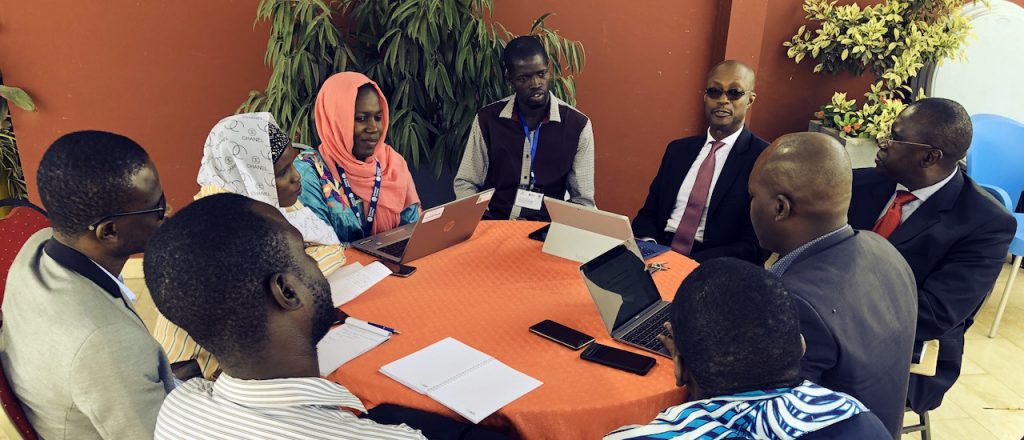Senegal Kicks Off Enhancing IoT Security Project

On April 4, 2018, the Canadian Multistakeholder Process: Enhancing Internet of Things (IoT) Security held its first convening in partnership with the Canadian Internet Registration Authority (CIRA); CANARIE; Innovation, Science and Economic Development (ISED) Canada; and the Canadian Internet Policy and Public Interest Clinic (CIPIC). Over 80 participants from government, academia, public interest, industry, and other organizations attended the first meeting and many have continued to engage at in-person and virtual meetings ever since. Over the past eight months, this group has experienced significant success in the areas of consumer education, labeling, and network resiliency. And these achievements have been well-noted on a global scale.
A delegation from Senegal came to Canada in July to meet with members of the Enhancing IoT Security oversight committee. The group was comprised of government officials, Senegal Chapter members, and staff from the Internet Society’s African Bureau. The delegation met with Canadian government officials, technologists, public interest groups, and North American Bureau staff to learn more about how and why the IoT security project was initiated, and what the group had accomplished to date. The group discussed the significant successes the Canadian multistakeholder group had already achieved, the challenges it faced, Continue reading
VMware Rolls Out NSX Service Mesh Based on Istio
 The NSX Service Mesh beta will initially support Cloud PKS (formerly known as VMware Kubernetes Engine or VKE), but VMware plans to extend it to any Kubernetes environment.
The NSX Service Mesh beta will initially support Cloud PKS (formerly known as VMware Kubernetes Engine or VKE), but VMware plans to extend it to any Kubernetes environment.
SDxCentral Weekly Wrap: AT&T White Box Routers Carry Live Traffic
 SDxCentral Weekly Wrap for Dec. 7, 2018: Huawei deals with a new scandal, Symantec's shakeup continues, and more of what you missed this week.
SDxCentral Weekly Wrap for Dec. 7, 2018: Huawei deals with a new scandal, Symantec's shakeup continues, and more of what you missed this week.
BT Excludes Huawei From Its 5G Core, Huawei’s CFO Is Arrested in Canada
 Huawei's' chief financial officer who is also the daughter of the founder of Huawei, was arrested in Canada at the request of the United States. The reason for the arrest has not been disclosed.
Huawei's' chief financial officer who is also the daughter of the founder of Huawei, was arrested in Canada at the request of the United States. The reason for the arrest has not been disclosed.
The Rising Costs of Cybersecurity Are Driving IT Modernization
 Regardless of size cybersecurity has become a massive source of frustration for organizations all sizes. A greater percentage of IT spending is now being consumed by cybersecurity products and services.
Regardless of size cybersecurity has become a massive source of frustration for organizations all sizes. A greater percentage of IT spending is now being consumed by cybersecurity products and services.
There’s Nothing Universal About the Universal CPE
 Achieving standard, commodity uCPEs will be a longer journey than anticipated.
Achieving standard, commodity uCPEs will be a longer journey than anticipated.
Kubernetes Discloses Major Security Flaw
 It affects all Kubernetes-based products and services, and it gives hackers full administrative privileges on any compute node being run in a Kubernetes cluster.
It affects all Kubernetes-based products and services, and it gives hackers full administrative privileges on any compute node being run in a Kubernetes cluster.
Nokia Threat Report: IoT Botnets Skyrocketed in 2018 and 5G Will Make It Worse
 “If you have an IoT device and it has any vulnerability and it’s visible from the Internet, it will be attacked in a number of minutes,” said Kevin McNamee, director of Nokia’s Threat Intelligence Lab and lead author of the report.
“If you have an IoT device and it has any vulnerability and it’s visible from the Internet, it will be attacked in a number of minutes,” said Kevin McNamee, director of Nokia’s Threat Intelligence Lab and lead author of the report.
Join Us to Discuss Attack Response at Internet Scale
How do we coordinate responses to attacks against Internet infrastructure and users? Internet technology has to scale or it won’t survive for long as the network of networks grows ever larger. But it’s not just the technology, it’s also the people, processes and organisations involved in developing, operating and evolving the Internet that need ways to scale up to the challenges that a growing global network can create.
One such challenge is unwanted traffic, ranging from spam and other forms of messaging-related abuse to multi-gigabit distributed denial of service attacks. Numerous incident response efforts exist to mitigate the effects of these attacks. Some are focused on specific attack types, while others are closed analysis and sharing groups spanning many attack types.
We are helping to bring together operators, researchers, CSIRT team members, service providers, vendors, information sharing and analysis centre members to discuss approaches to coordinating attack response at Internet scale. The Internet Society is sponsoring a two-day “Coordinating Attack Response at Internet Scale (CARIS) Workshop” intended to help build bridges between the many communities working on attack response on the Internet and to foster dialogue about how we can better collaborate.
The workshop will take place on February 28 Continue reading
Juniper’s ATP Appliance Works With Any Third-Party Firewall or Security Data Source
 New capabilities allow security teams to create custom data collectors in the appliance using threat data from any Juniper or third-party firewall. This eliminates the need for custom code or pre-defined integrations.
New capabilities allow security teams to create custom data collectors in the appliance using threat data from any Juniper or third-party firewall. This eliminates the need for custom code or pre-defined integrations.
Symantec Shakeup Continues With President, Other Senior Execs Leaving
 The executive team shakeup caps a tumultuous year for the company that recently concluded an internal investigation into financial disclosures and announced plans to cut about 8 percent of its global workforce.
The executive team shakeup caps a tumultuous year for the company that recently concluded an internal investigation into financial disclosures and announced plans to cut about 8 percent of its global workforce.
David Gee on Security of Network Automation
One of the points David Gee, a guest speaker in Spring 2019 Building Networking Automation Solutions online course, and Christoph Jaggi touched on in their interview was the security of network automation solutions (see also: automated workflows and hygiene of network automation).
What are the security risks for automation?
Security is an approach, not an afterthought.
Read more ...Securify: practical security analysis of smart contracts
Securify: practical security analysis of smart contracts Tsankov et al., CCS’18
Sometimes the perfect is the enemy of the good. When we’re talking about securing smart contracts, we need all the help we can get! Bugs can cost millions of dollars. Securify uses a set of expert heuristics (patterns) to help identify issues in smart contracts. It’s available at https://securify.ch, has analysed over 18K uploaded contracts, and is used by security auditors as part of their arsenal.
The increased adoption of smart contracts demands strong security guarantees. Unfortunately, it is challenging to create smart contracts that are free of security bugs. As a consequence, critical vulnerabilities in smart contracts are discovered and exploited every few months. In turn, these exploits have led to losses reaching millions worth of USD in the past few years…. Despite their potential, repeated security concerns have shaken the trust in handling billions of USD by smart contracts.
Too right! We’ve examined some of the challenges involved in creating correct smart contracts in previous editions of The Morning Paper, as well as tools such as Zeus that help with verification.
It’s not a solvable problem in the general case (i.e., ‘perfect’ Continue reading
Customer Data Isn’t Always an Asset: Lessons from the Marriott Data Breach

As data analytics have improved, the massive amounts of data that companies acquire from their customers has only gained in economic value. In the corporate world of today, this data can be a real asset for companies. However, as today’s news, that the records of over 500 million guests of Marriott International’s Starwood division hotels were involved in a data breach, makes clear, corporate thinking about the value of customer data needs to be reevaluated.
Especially when it comes to corporate acquisitions, companies need to start treating customer data as a potential liability, as well as an asset.
In September 2016, Marriott International acquired Starwood for $13.6 billion. When Marriott International sought to buy the Starwood hotel chain, Starwood’s customer data, played a central role in their reasoning for the acquisition. Citing higher income and better brand loyalty among program members, Arne Sorenson, the Marriott CEO, specifically referred to Starwood’s loyalty program as a “central, strategic rationale for the transaction.” Loyalty programs, in addition to attracting repeat customers, also “provide hotels with a wealth of information on their guests” which hotels can use to “create laser focused marketing campaigns for various different kinds of guests.”
While Continue reading
Cisco, AT&T, Intel Promote Best Anti-Botnet Practices for Companies
 The anti-botnet guide provides best practices for service providers, enterprises, and software and device manufacturers.
The anti-botnet guide provides best practices for service providers, enterprises, and software and device manufacturers.
A Critical First Step for IoT Security in Senegal

As barriers to entry start to fall, the Internet of Things (IoT) industry could provide Africa with an opportunity to build a brighter economic future.
Several countries are already establishing tech hubs that could supply the infrastructure to fuel IoT, and while there is still a wide gap between the haves and have-nots of Internet access, with more than 60 per cent of Africa still offline, it’s easy to build a case for connectivity.
Mass urbanization is on the rise, and investing in the infrastructure needed to fuel future smart cities and connect more Africans to the opportunity the Internet offers is a logical step forward. But it’s also important that security is in place to support this promising new economy.
Unfortunately, many IoT devices are rushed to market with little thought for basic security and privacy protections. In a world with so many newly connected things, it’s hard for consumers to keep up – and to know if manufactures are protecting their privacy and security.
To address this, Senegal has taken a critical first step. They’ve signed a memorandum of understanding with the Internet Society to strengthen IoT security. Together, they will develop an IoT Security Framework for Senegal Continue reading
StackPath EdgeEngine Uses Serverless to Strip Edge Deployment Complexity
 Developers only need to upload their own code, which is then automatically deployed to the edge in an isolated runtime environment.
Developers only need to upload their own code, which is then automatically deployed to the edge in an isolated runtime environment.
VMware Tech Prevents Cyberattacks Across Texas School Districts
 Two VMware customers, a Texas Education Service Center and a nationwide hospice company, say NSX and vRealize Network helped them secure and manage networks.
Two VMware customers, a Texas Education Service Center and a nationwide hospice company, say NSX and vRealize Network helped them secure and manage networks.
SD-WAN in 2019: The Conundrum for Service Providers
 To succeed in SD-WAN, service providers will need to transform their organization and improve their selling skills. Can they do it?
To succeed in SD-WAN, service providers will need to transform their organization and improve their selling skills. Can they do it?
Know your SCM_RIGHTS
As TLS 1.3 was ratified earlier this year, I was recollecting how we got started with it here at Cloudflare. We made the decision to be early adopters of TLS 1.3 a little over two years ago. It was a very important decision, and we took it very seriously.
It is no secret that Cloudflare uses nginx to handle user traffic. A little less known fact, is that we have several instances of nginx running. I won’t go into detail, but there is one instance whose job is to accept connections on port 443, and proxy them to another instance of nginx that actually handles the requests. It has pretty limited functionality otherwise. We fondly call it nginx-ssl.
Back then we were using OpenSSL for TLS and Crypto in nginx, but OpenSSL (and BoringSSL) had yet to announce a timeline for TLS 1.3 support, therefore we had to implement our own TLS 1.3 stack. Obviously we wanted an implementation that would not affect any customer or client that would not enable TLS 1.3. We also needed something that we could iterate on quickly, because the spec was very fluid back then, and also something Continue reading